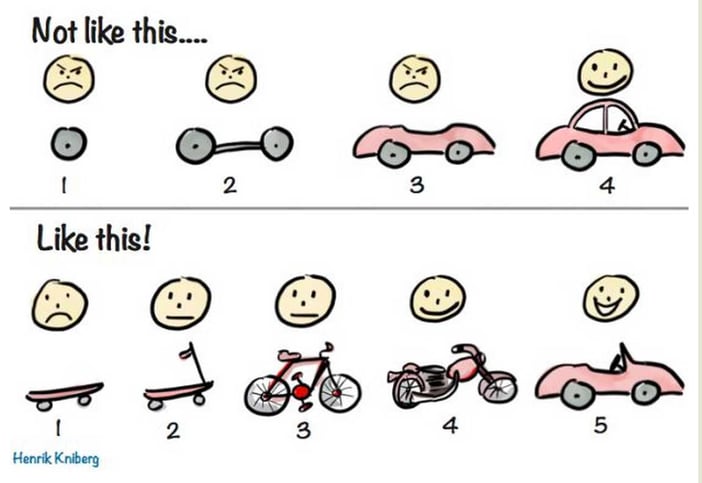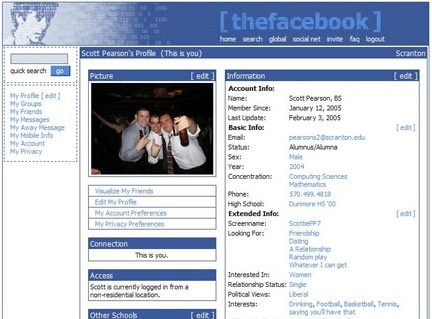Designers and marketing teams often take one look at an ugly website and think, “We’ll have to redo the whole thing.” Nearly every Human Marketing client has been the victim of a website repair or redesign that tanked SEO rankings.
When a new client is looking for a new and improved website, our immediate thought isn’t to redo the entire thing — not matter how visually painful it might be. Our goal of a website repair is to help you make money as quickly as possible and see some positive ROI.
Build Off What Works
Often, clients come to us with a working site (not a great one, but it works). Instead of building a new one from the ground up, we make calculated repairs of the site over time, careful not to disturb existing SEO rankings. Consider this illustration:

If your business survives off online leads and sales, waiting three or six months for a site redesign is expensive. Learn how much your website should cost.
Making small tweaks to a functional site (like the wagon illustrated above) that improve conversion rates is a much safer approach.
So how do you find what works on your website? Here's a deeper look at our mindset during a website repair.
Make It Mobile-Friendly, Man!
If your site isn’t mobile-friendly, you should tackle this early on. Think of every touchpoint your customers and contacts go through with your brand. Ninety percent of the time, they're opening emails on a phone or tablet. If either your email or website isn't optimized for mobile screens, your mobile traffic will suffer. It doesn't matter how compelling the email copy; if your email sends contacts to a site that's difficult to navigate, they won't follow through.
Dig Into the Funnel & Attack Problem Areas First
Your Google Analytics is a gold mine of information around your funnel. You can easily see where people get hung up and attack those problem areas first. Focusing on these areas will help you get the biggest return right away. The conversion path that works the best might even surprise you.
Once we locate where people are dropping off, we redo that section (while A/B testing the original, of course) or make it more obvious to a user where they SHOULD go. For an e-commerce site we recently worked on, we noticed users who came from organic search were 10% more likely to check out than users who went through a product category page. So we redesigned the page to encourage users to search for products rather than navigate by category. This simple change lifted conversions by more than 10%.
Pick Low-Hanging Fruit
We love finding low-hanging fruit that produces ROI early on for clients. One way to accomplish this is through retargeting ads. People who've already been to your site — and maybe even jumped around a few pages — are hot leads. Why start the cycle with new prospects when you can encourage these qualified prospects to purchase? Or, maybe an email blasts will encourage existing customers to return. These are relatively cheap campaigns that will create some traction.
Don't Shock Users; Update Over Time
It can take months for your organic efforts to take root. That's why we balance other ROI-producing initiatives (like conversion rate optimization) while sowing the organic seeds.
When we begin redoing full webpages and creating new content, we're careful not to shock visitors. Users typically seem confused when a site changes too much too fast. They'll almost always adjust, but if you change things slowly enough, it eases the pain a little more. Just consider this hilariously accurate example of the Facebook platform:

That being said, had facebook not changed at all, you probably would’ve stopped using it by now. The idea "always be updating" is key here.

Which brings us back to the original illustration. Facebook started out with a rough yet functional site. It was basically a directory of people, allowing you to see general demographic information. Today, the team has added chat features, ad capabilities, video and so much more. They listened to users and built a robust website over time.
Think about it this way. When you need repairs after a car accident, the technician doesn't toss the working parts and build a new one from scratch. He fixes what is broken first. Then he might recommend other repairs like an oil change or new break pads to keep your car running smoothly.
The whole idea of a website is to help visitors get the information, products or services they need. It might not look like a million-dollar site from the get-go, but what matters is making money, observing user behavior and optimizing accordingly. (After all, you did build the website for your customers, right?)
Similarly, your inbound marketing company should locate the parts of your website that work and build upon that foundation.
Need help optimizing or repairing your website? We'd be happy to help!




